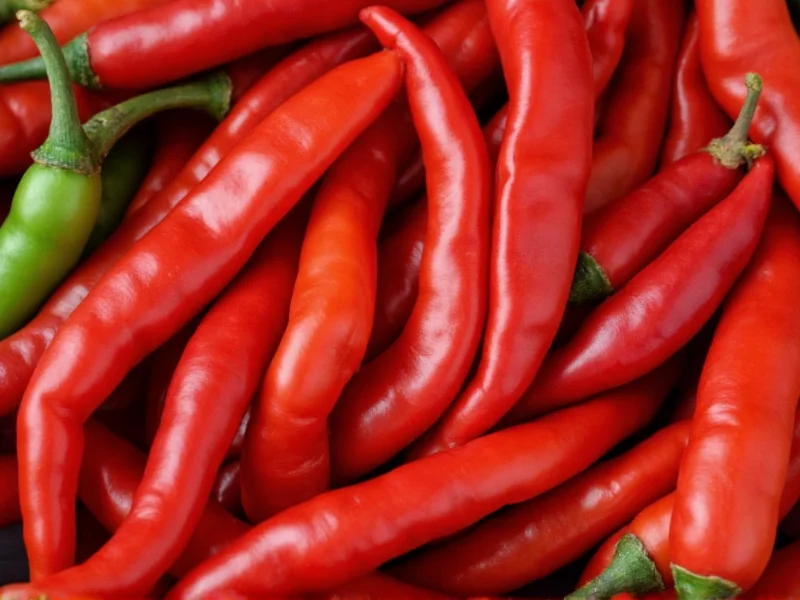When you bite into a fiery chilli pepper, it's capsaicin interacting with your TRPV1 receptors that creates that unmistakable burning sensation. This compound, found primarily in the placental tissue surrounding chilli seeds, tricks your nervous system into perceiving heat where none physically exists. Unlike actual thermal heat, capsaicin's effect comes from its unique molecular structure binding to specific pain receptors.
Understanding what causes the burning sensation in chilli requires examining capsaicin's biochemical properties. This lipophilic molecule easily dissolves in fats and oils but not in water, explaining why drinking water rarely helps when your mouth is on fire. Instead, dairy products containing casein provide better relief as they can break the bond between capsaicin and your receptors.
The Science Behind Capsaicin Production
Chilli plants evolved to produce capsaicin as a defense mechanism against mammals. While birds can eat chillies without feeling the burn (they lack TRPV1 receptors), mammals like rodents avoid them, allowing birds to disperse the seeds widely. This evolutionary adaptation explains why do chillies produce capsaicin in the first place.
Measuring Chilli Heat: The Scoville Scale Explained
In 1912, pharmacist Wilbur Scoville developed a method to quantify chilli heat by diluting extracts until the burning sensation disappeared. Today's high-performance liquid chromatography provides more precise measurements, but the Scoville Heat Units (SHU) remain the standard reference.
| Chilli Variety | Scoville Heat Units | Common Uses |
|---|---|---|
| Bell Pepper | 0 SHU | Raw consumption, cooking |
| Jalapeño | 2,500-8,000 SHU | Salsas, nachos, pickled |
| Habanero | 100,000-350,000 SHU | Hot sauces, Caribbean cuisine |
| Ghost Pepper | 855,000-1,041,427 SHU | Extreme hot sauces, challenges |
| Carolina Reaper | 1,400,000-2,200,000 SHU | World's hottest sauces |
Why Heat Varies Among Chilli Varieties
The difference between heat and spiciness in chillies comes down to genetics and environmental factors. While all chillies contain capsaicinoids (the family of compounds including capsaicin), their concentration varies dramatically based on:
- Genetic makeup of the specific cultivar
- Soil conditions and nutrient availability
- Water stress during growth
- Sun exposure levels
- Ripeness when harvested
Interestingly, the hottest part of a chilli isn't the seeds as commonly believed, but the white pithy membrane surrounding them. Seeds may contain capsaicin only through contact with this membrane.
Human Response to Capsaicin: More Than Just Pain
When capsaicin binds to TRPV1 receptors, it triggers a complex physiological response. Your body releases endorphins to counter the perceived threat, creating what many describe as a 'chilli high.' This explains why are chillies spicy yet so many people enjoy them despite the initial discomfort.
Regular consumption can lead to desensitization as nerve endings become temporarily depleted of substance P, the neurotransmitter responsible for pain signaling. This adaptation allows chilli enthusiasts to gradually build tolerance to increasingly hotter varieties.
Practical Applications of Chilli Heat Knowledge
Understanding how does capsaicin work has practical implications beyond culinary enjoyment. Food scientists use this knowledge to develop products with controlled heat levels, while medical researchers study capsaicin's potential for pain management. The compound's ability to trigger thermogenesis also makes it popular in weight-loss supplements.
When dealing with excessive chilli heat, remember that capsaicin's fat-soluble nature means dairy, oils, or sugary substances provide better relief than water. Understanding these principles helps both home cooks and professional chefs manage heat levels effectively.
Frequently Asked Questions
Why don't birds feel the heat from chillies?
Birds lack the TRPV1 receptors that mammals have, which are activated by capsaicin. This evolutionary adaptation allows birds to eat chillies and disperse the seeds without damage, while mammals avoid them.
Does cooking affect chilli heat?
Cooking can slightly reduce chilli heat as capsaicin breaks down at high temperatures, but the effect is minimal. More significantly, cooking distributes capsaicin throughout the dish, potentially making the heat feel more intense as it's not concentrated in specific parts.
Why do some people enjoy extremely hot chillies?
The burning sensation from capsaicin triggers endorphin release, creating a natural 'high.' Regular consumers often develop both physiological tolerance and psychological enjoyment of this endorphin rush, similar to the experience of runners' high.
Can you build tolerance to chilli heat?
Yes, regular exposure to capsaicin depletes substance P in nerve endings, temporarily reducing sensitivity. This desensitization allows people to gradually consume hotter chillies over time, though the effect reverses when exposure stops.
Why does milk help with chilli burn?
Milk contains casein, a protein that binds to capsaicin and helps wash it away from pain receptors. Since capsaicin is fat-soluble, the fat content in whole milk makes it particularly effective compared to water, which simply spreads the oil-based compound.











 浙公网安备
33010002000092号
浙公网安备
33010002000092号 浙B2-20120091-4
浙B2-20120091-4